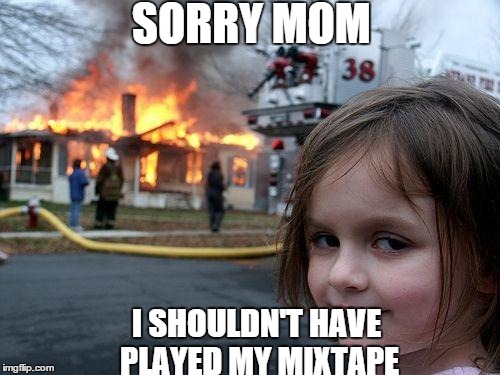Common Sense by Thomas Paine was a pamphlet that supported the American Revolution. Catering to its time, it caught the attention of individuals far and wide and became "viral" in the best way one could in the 18th century. With this in mind, it brings to light that virality of content of something that matters and social media is not foreign to history.
Disaster Girl is a meme or a image used along with a appropriate caption that implies delivish behaviour, all while remaining calm. In comparison to the two pieces, there can be some correlations of how they both are considered "viral". Kevin Alloca states that in order for something to become famous, it specifically has to concern itself with three elements, tastemakers, community of participation and unexpectedness in which are evident within both Common Sense and Disaster Girl.
It is stated that within the first articulation of something to go viral you must look at the mode of communication, the mode of affect, and mode of accumulation. Here, we can see that the mode of communication of this particular meme is done through the text. In addition to this, it will sometimes have an additional caption. This is similar to Paines use of spacing and commas. Mode of affect is done from the emotion of the Disaster Girl, which can make you laugh or make you feel an inner 'trouble child'. Finally, mode of accumulation is done by how youth are inclined to use it.
Virality between the 18th and 21st century have clear differences in terms in production and consumption but it does not take away from how we view it now. It is truly clear that now even with the differences, there are similarities with a topic such as virality.

I agree with your comparison of Disaster Girl with Kevin Alloca statement on viral videos. The meme I chose 'Ain't nobody got time for that' also correlates with this statement. Both display a sense of surprise element that catches the audience off guard. This element creates a sense of humour that everyone enjoys. In addition, I like how you stated that there are both differences and similarities to the virality in the 18th and 21 century. They are completely different in the sense of technology used. However,both the message communicated became common discourse throughout the public sphere
ReplyDeleteI liked how you used your own example for this post and related it to Disaster Girl. I also enjoyed how you talked about viewing this meme as something humorous, but also as something relatable. For example, reminiscing on your inner devil child. As consumers of media, it is important for us to be able to relate to these viral memes.
ReplyDeleteGreat post Emma! I liked that you chose the "disaster girl" meme - definitely one of my faves. I liked that you chose to look at Kevin Alloca's understanding of virality. The third aspect, "unexpectedness" is apparent with this meme, as the girls facial expression and the evident fire in the background creates quite a dichotomous photo and adds a "shock" factor for the viewer. I also agree with your statement that even with the difference in modes of production and consumption from the 18th century, the concept of virality continues to have many similarities. One similarity I notice is that these mediums that go viral pertain to address social anxieties and fears - just like the disaster girl, or like my post, Ryan Gosling being your cheerleader during final exams.
ReplyDeleteGreat post! I like how you related Kevin Alloca's definition of virality to the "disaster girl" meme. As the other comments have said, this meme is very unexpected because of the young girl's expression and what is happening in the background. This meme is one of my favourites and I'm so glad that someone chose to relate it to Paine's Common Sense.
ReplyDelete